Report: Structural Analysis of a Print Advertisement (McDonalds)
VerifiedAdded on 2022/11/17
|10
|1732
|477
Report
AI Summary
This report provides a structural analysis of the McDonalds "Loose Change" campaign advertisement. The analysis begins with an executive summary, followed by an introduction that highlights the purpose of advertisements and the chosen ad. The report then delves into the structural components of the ad, including the headline, sub-headline, benefits, image, and call-to-action, although the selected ad's structure deviates from the traditional format. The target market, primarily children, teenagers, and low-income individuals, is identified. The creative elements, emphasizing uniqueness and artistic value, are examined, along with the ad's media strategy, focusing on print and digital media. The Unique Selling Proposition (USP) of low prices is discussed, along with the strengths of the campaign (brand value and wide product variety) and its weaknesses (health concerns and environmental lawsuits). The report highlights the campaign's effectiveness, citing market share gains. Finally, the report concludes by emphasizing the role of proper marketing strategy, target market selection, and media context in the success of the campaign and the impact of the brand name. The references are provided at the end.
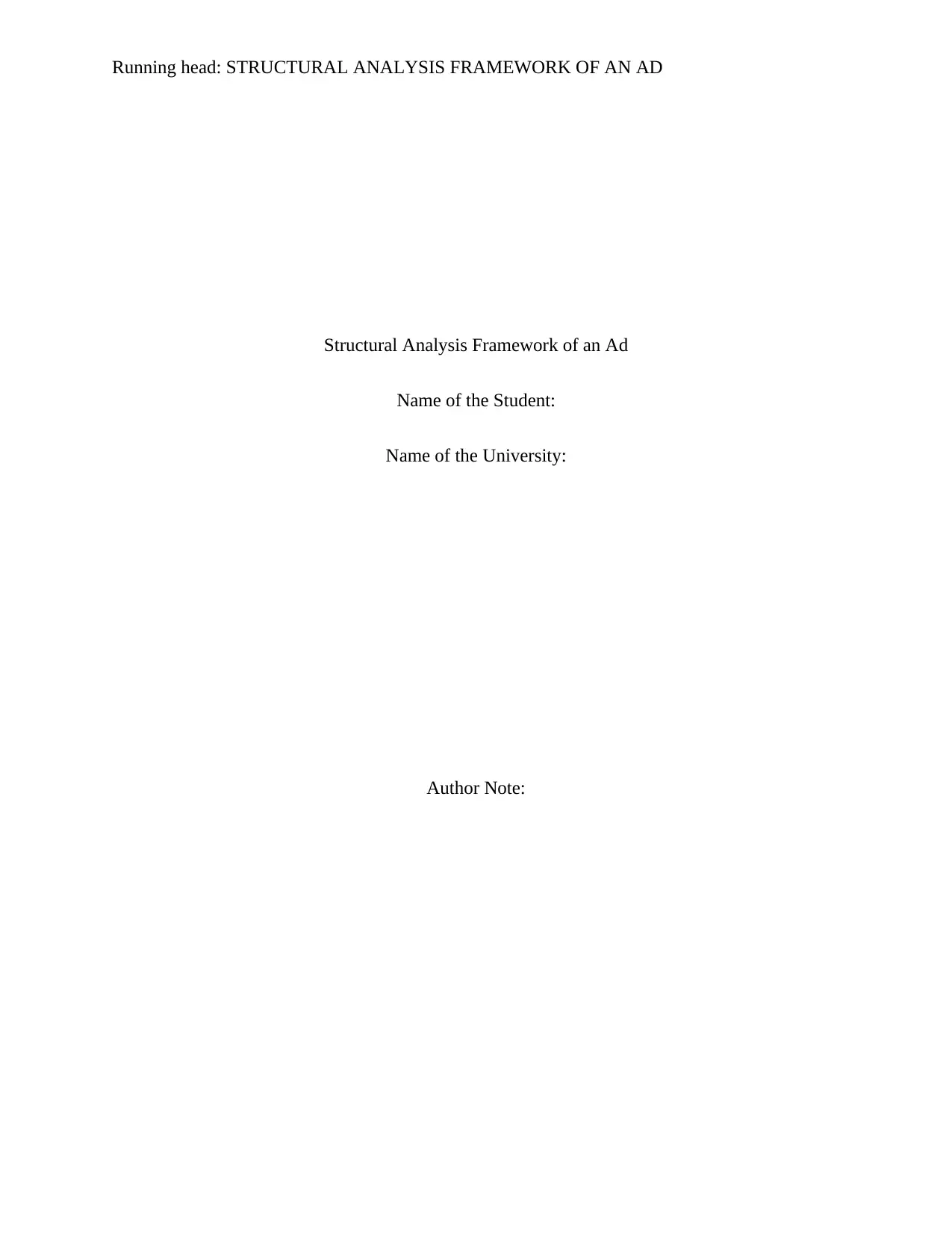
Running head: STRUCTURAL ANALYSIS FRAMEWORK OF AN AD
Structural Analysis Framework of an Ad
Name of the Student:
Name of the University:
Author Note:
Structural Analysis Framework of an Ad
Name of the Student:
Name of the University:
Author Note:
Paraphrase This Document
Need a fresh take? Get an instant paraphrase of this document with our AI Paraphraser
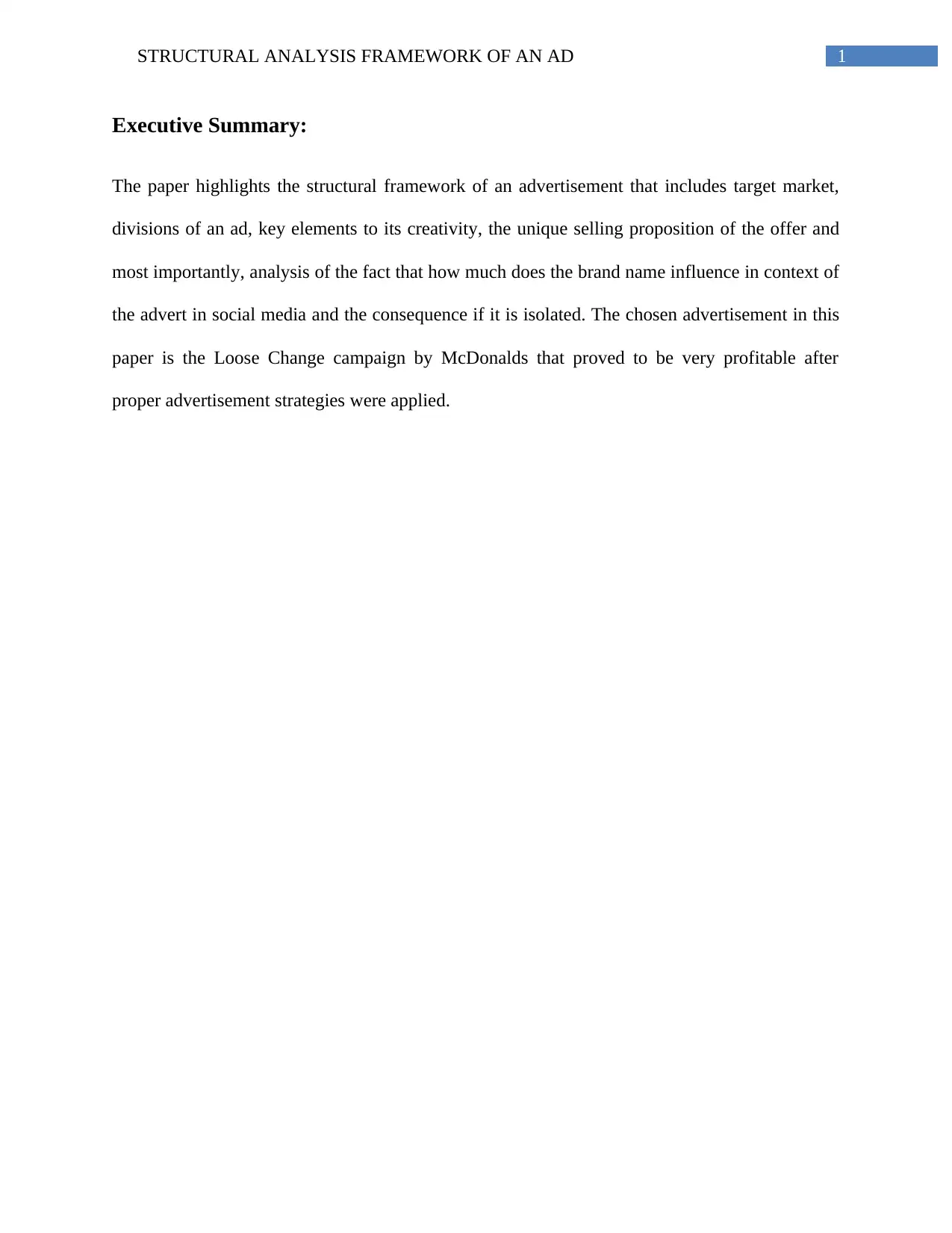
1STRUCTURAL ANALYSIS FRAMEWORK OF AN AD
Executive Summary:
The paper highlights the structural framework of an advertisement that includes target market,
divisions of an ad, key elements to its creativity, the unique selling proposition of the offer and
most importantly, analysis of the fact that how much does the brand name influence in context of
the advert in social media and the consequence if it is isolated. The chosen advertisement in this
paper is the Loose Change campaign by McDonalds that proved to be very profitable after
proper advertisement strategies were applied.
Executive Summary:
The paper highlights the structural framework of an advertisement that includes target market,
divisions of an ad, key elements to its creativity, the unique selling proposition of the offer and
most importantly, analysis of the fact that how much does the brand name influence in context of
the advert in social media and the consequence if it is isolated. The chosen advertisement in this
paper is the Loose Change campaign by McDonalds that proved to be very profitable after
proper advertisement strategies were applied.
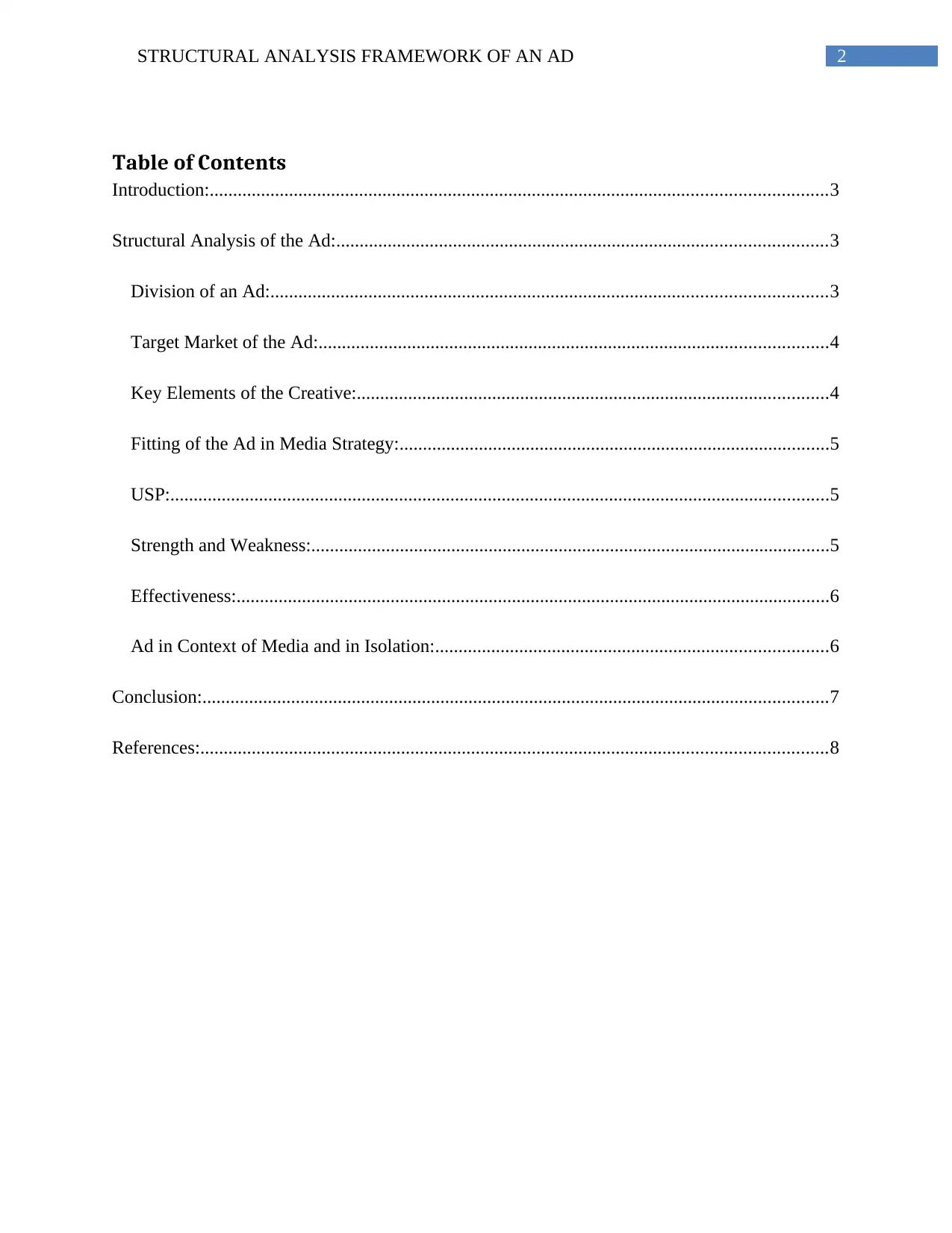
2STRUCTURAL ANALYSIS FRAMEWORK OF AN AD
Table of Contents
Introduction:....................................................................................................................................3
Structural Analysis of the Ad:.........................................................................................................3
Division of an Ad:.......................................................................................................................3
Target Market of the Ad:.............................................................................................................4
Key Elements of the Creative:.....................................................................................................4
Fitting of the Ad in Media Strategy:............................................................................................5
USP:.............................................................................................................................................5
Strength and Weakness:...............................................................................................................5
Effectiveness:...............................................................................................................................6
Ad in Context of Media and in Isolation:....................................................................................6
Conclusion:......................................................................................................................................7
References:......................................................................................................................................8
Table of Contents
Introduction:....................................................................................................................................3
Structural Analysis of the Ad:.........................................................................................................3
Division of an Ad:.......................................................................................................................3
Target Market of the Ad:.............................................................................................................4
Key Elements of the Creative:.....................................................................................................4
Fitting of the Ad in Media Strategy:............................................................................................5
USP:.............................................................................................................................................5
Strength and Weakness:...............................................................................................................5
Effectiveness:...............................................................................................................................6
Ad in Context of Media and in Isolation:....................................................................................6
Conclusion:......................................................................................................................................7
References:......................................................................................................................................8
⊘ This is a preview!⊘
Do you want full access?
Subscribe today to unlock all pages.

Trusted by 1+ million students worldwide
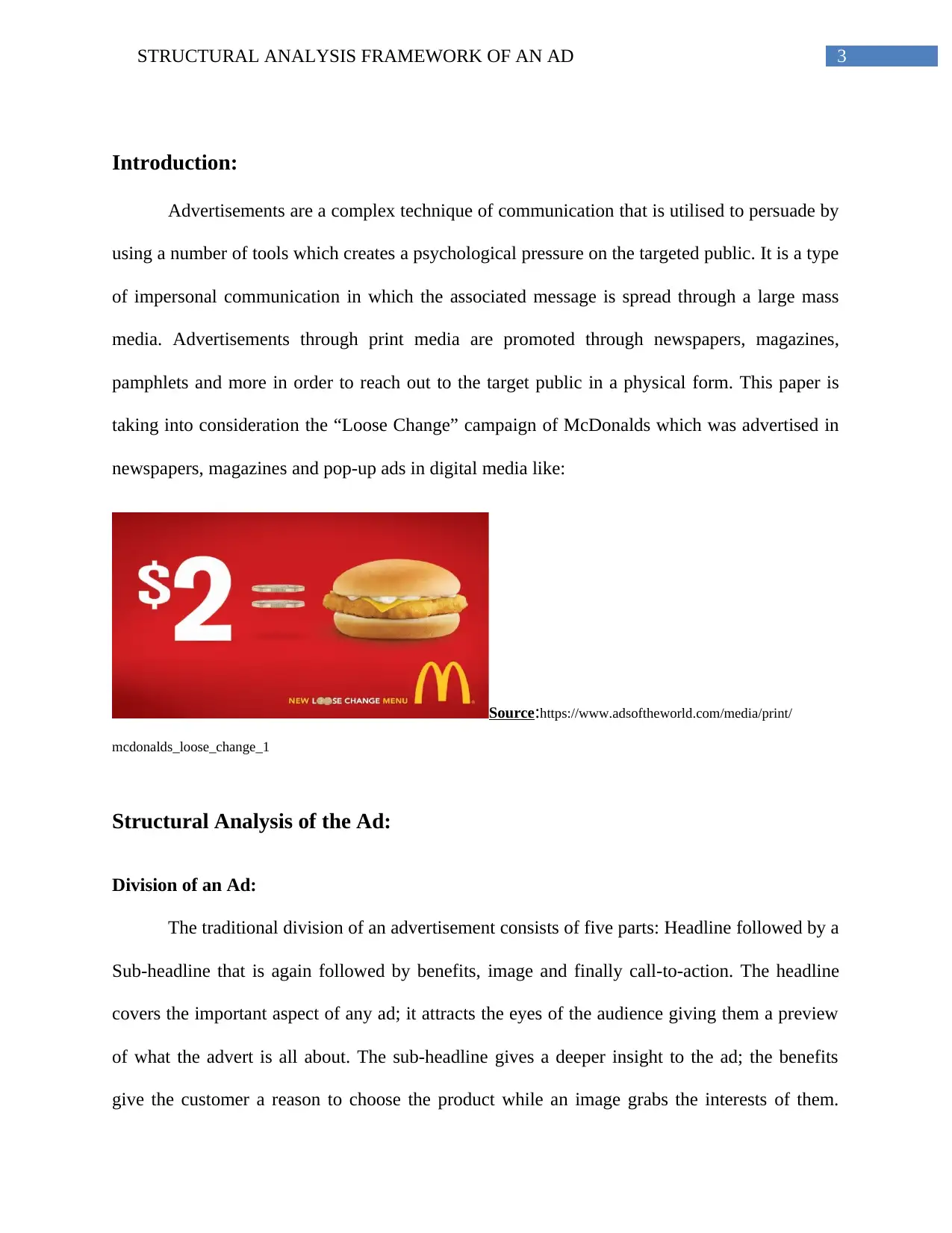
3STRUCTURAL ANALYSIS FRAMEWORK OF AN AD
Introduction:
Advertisements are a complex technique of communication that is utilised to persuade by
using a number of tools which creates a psychological pressure on the targeted public. It is a type
of impersonal communication in which the associated message is spread through a large mass
media. Advertisements through print media are promoted through newspapers, magazines,
pamphlets and more in order to reach out to the target public in a physical form. This paper is
taking into consideration the “Loose Change” campaign of McDonalds which was advertised in
newspapers, magazines and pop-up ads in digital media like:
Source:https://www.adsoftheworld.com/media/print/
mcdonalds_loose_change_1
Structural Analysis of the Ad:
Division of an Ad:
The traditional division of an advertisement consists of five parts: Headline followed by a
Sub-headline that is again followed by benefits, image and finally call-to-action. The headline
covers the important aspect of any ad; it attracts the eyes of the audience giving them a preview
of what the advert is all about. The sub-headline gives a deeper insight to the ad; the benefits
give the customer a reason to choose the product while an image grabs the interests of them.
Introduction:
Advertisements are a complex technique of communication that is utilised to persuade by
using a number of tools which creates a psychological pressure on the targeted public. It is a type
of impersonal communication in which the associated message is spread through a large mass
media. Advertisements through print media are promoted through newspapers, magazines,
pamphlets and more in order to reach out to the target public in a physical form. This paper is
taking into consideration the “Loose Change” campaign of McDonalds which was advertised in
newspapers, magazines and pop-up ads in digital media like:
Source:https://www.adsoftheworld.com/media/print/
mcdonalds_loose_change_1
Structural Analysis of the Ad:
Division of an Ad:
The traditional division of an advertisement consists of five parts: Headline followed by a
Sub-headline that is again followed by benefits, image and finally call-to-action. The headline
covers the important aspect of any ad; it attracts the eyes of the audience giving them a preview
of what the advert is all about. The sub-headline gives a deeper insight to the ad; the benefits
give the customer a reason to choose the product while an image grabs the interests of them.
Paraphrase This Document
Need a fresh take? Get an instant paraphrase of this document with our AI Paraphraser
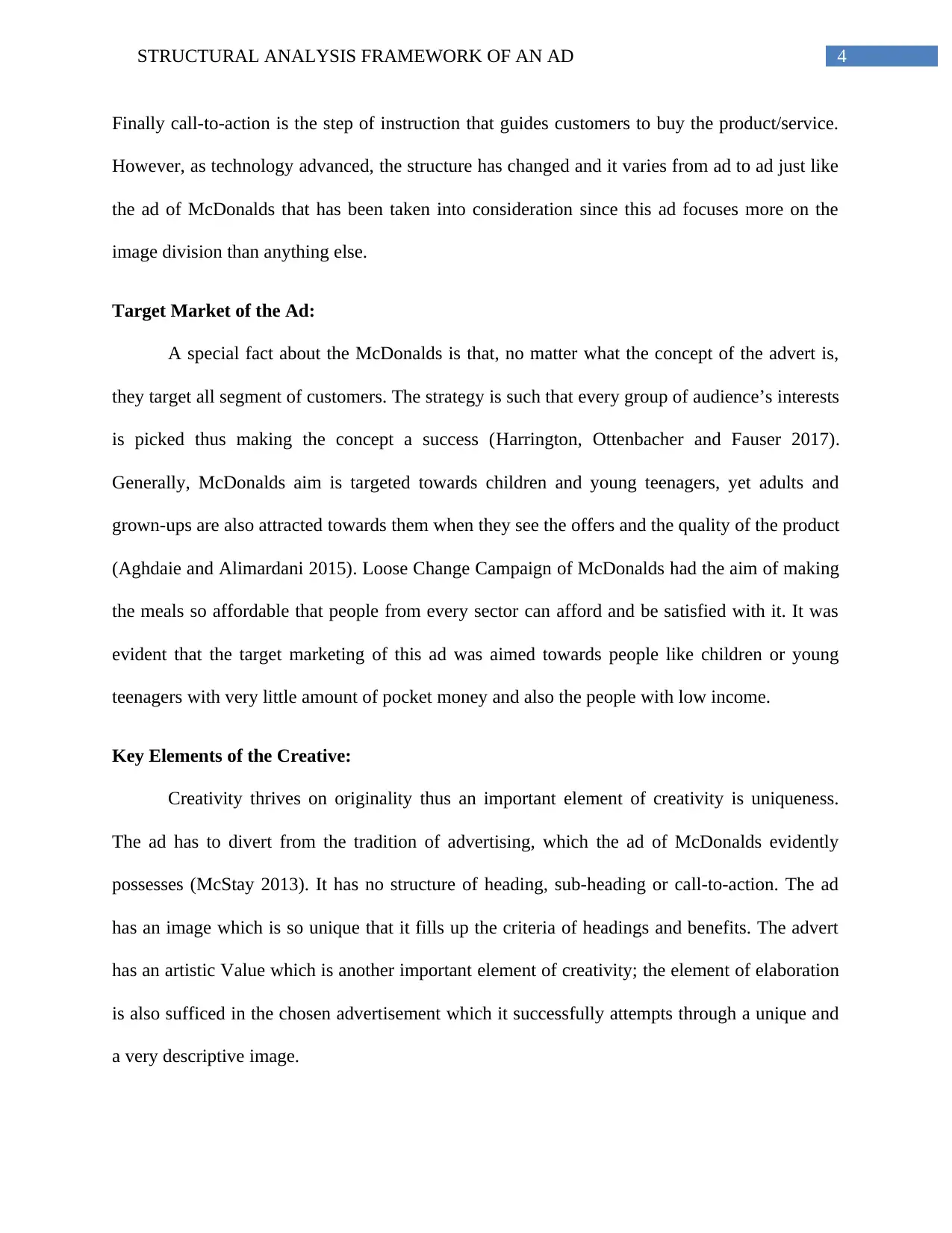
4STRUCTURAL ANALYSIS FRAMEWORK OF AN AD
Finally call-to-action is the step of instruction that guides customers to buy the product/service.
However, as technology advanced, the structure has changed and it varies from ad to ad just like
the ad of McDonalds that has been taken into consideration since this ad focuses more on the
image division than anything else.
Target Market of the Ad:
A special fact about the McDonalds is that, no matter what the concept of the advert is,
they target all segment of customers. The strategy is such that every group of audience’s interests
is picked thus making the concept a success (Harrington, Ottenbacher and Fauser 2017).
Generally, McDonalds aim is targeted towards children and young teenagers, yet adults and
grown-ups are also attracted towards them when they see the offers and the quality of the product
(Aghdaie and Alimardani 2015). Loose Change Campaign of McDonalds had the aim of making
the meals so affordable that people from every sector can afford and be satisfied with it. It was
evident that the target marketing of this ad was aimed towards people like children or young
teenagers with very little amount of pocket money and also the people with low income.
Key Elements of the Creative:
Creativity thrives on originality thus an important element of creativity is uniqueness.
The ad has to divert from the tradition of advertising, which the ad of McDonalds evidently
possesses (McStay 2013). It has no structure of heading, sub-heading or call-to-action. The ad
has an image which is so unique that it fills up the criteria of headings and benefits. The advert
has an artistic Value which is another important element of creativity; the element of elaboration
is also sufficed in the chosen advertisement which it successfully attempts through a unique and
a very descriptive image.
Finally call-to-action is the step of instruction that guides customers to buy the product/service.
However, as technology advanced, the structure has changed and it varies from ad to ad just like
the ad of McDonalds that has been taken into consideration since this ad focuses more on the
image division than anything else.
Target Market of the Ad:
A special fact about the McDonalds is that, no matter what the concept of the advert is,
they target all segment of customers. The strategy is such that every group of audience’s interests
is picked thus making the concept a success (Harrington, Ottenbacher and Fauser 2017).
Generally, McDonalds aim is targeted towards children and young teenagers, yet adults and
grown-ups are also attracted towards them when they see the offers and the quality of the product
(Aghdaie and Alimardani 2015). Loose Change Campaign of McDonalds had the aim of making
the meals so affordable that people from every sector can afford and be satisfied with it. It was
evident that the target marketing of this ad was aimed towards people like children or young
teenagers with very little amount of pocket money and also the people with low income.
Key Elements of the Creative:
Creativity thrives on originality thus an important element of creativity is uniqueness.
The ad has to divert from the tradition of advertising, which the ad of McDonalds evidently
possesses (McStay 2013). It has no structure of heading, sub-heading or call-to-action. The ad
has an image which is so unique that it fills up the criteria of headings and benefits. The advert
has an artistic Value which is another important element of creativity; the element of elaboration
is also sufficed in the chosen advertisement which it successfully attempts through a unique and
a very descriptive image.
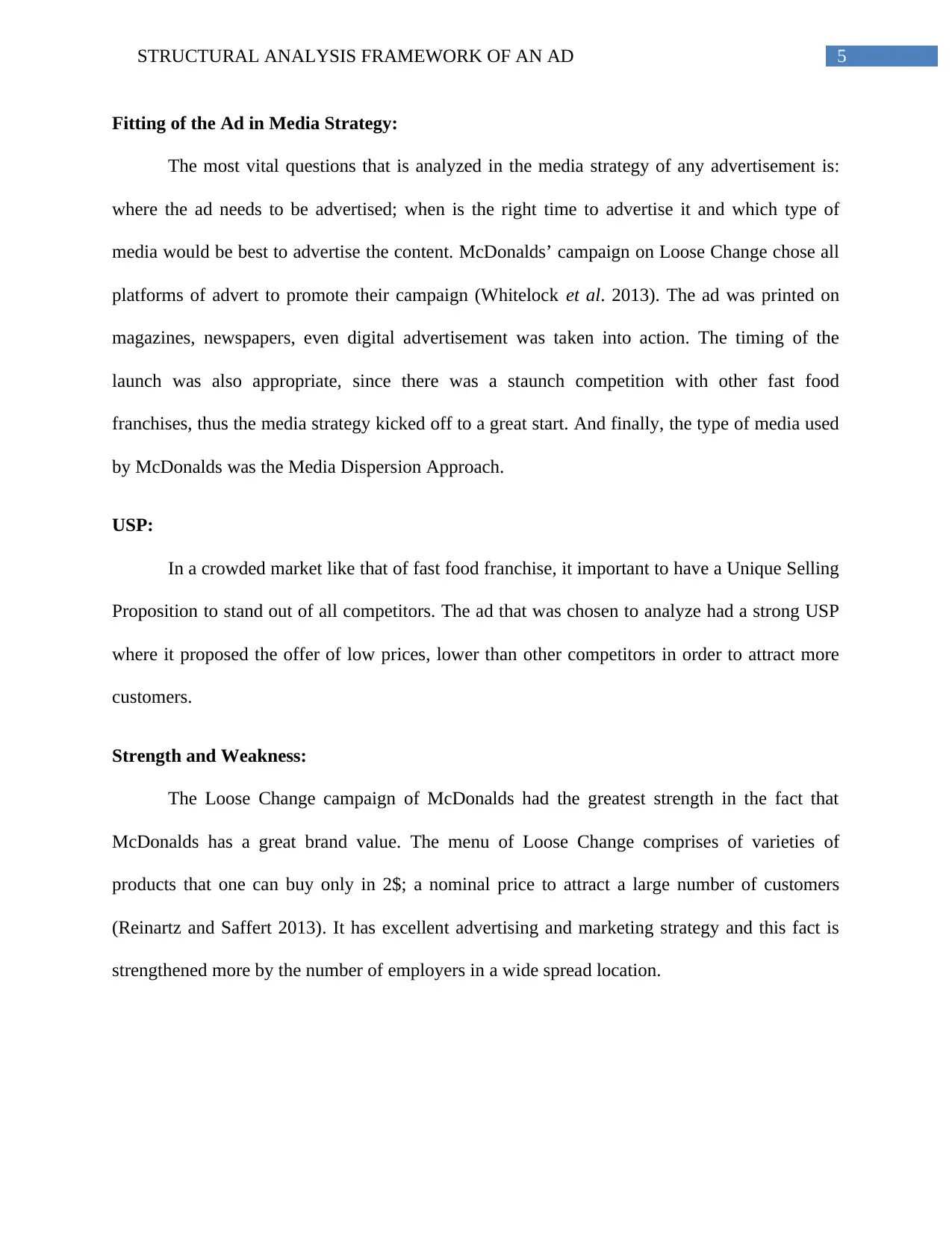
5STRUCTURAL ANALYSIS FRAMEWORK OF AN AD
Fitting of the Ad in Media Strategy:
The most vital questions that is analyzed in the media strategy of any advertisement is:
where the ad needs to be advertised; when is the right time to advertise it and which type of
media would be best to advertise the content. McDonalds’ campaign on Loose Change chose all
platforms of advert to promote their campaign (Whitelock et al. 2013). The ad was printed on
magazines, newspapers, even digital advertisement was taken into action. The timing of the
launch was also appropriate, since there was a staunch competition with other fast food
franchises, thus the media strategy kicked off to a great start. And finally, the type of media used
by McDonalds was the Media Dispersion Approach.
USP:
In a crowded market like that of fast food franchise, it important to have a Unique Selling
Proposition to stand out of all competitors. The ad that was chosen to analyze had a strong USP
where it proposed the offer of low prices, lower than other competitors in order to attract more
customers.
Strength and Weakness:
The Loose Change campaign of McDonalds had the greatest strength in the fact that
McDonalds has a great brand value. The menu of Loose Change comprises of varieties of
products that one can buy only in 2$; a nominal price to attract a large number of customers
(Reinartz and Saffert 2013). It has excellent advertising and marketing strategy and this fact is
strengthened more by the number of employers in a wide spread location.
Fitting of the Ad in Media Strategy:
The most vital questions that is analyzed in the media strategy of any advertisement is:
where the ad needs to be advertised; when is the right time to advertise it and which type of
media would be best to advertise the content. McDonalds’ campaign on Loose Change chose all
platforms of advert to promote their campaign (Whitelock et al. 2013). The ad was printed on
magazines, newspapers, even digital advertisement was taken into action. The timing of the
launch was also appropriate, since there was a staunch competition with other fast food
franchises, thus the media strategy kicked off to a great start. And finally, the type of media used
by McDonalds was the Media Dispersion Approach.
USP:
In a crowded market like that of fast food franchise, it important to have a Unique Selling
Proposition to stand out of all competitors. The ad that was chosen to analyze had a strong USP
where it proposed the offer of low prices, lower than other competitors in order to attract more
customers.
Strength and Weakness:
The Loose Change campaign of McDonalds had the greatest strength in the fact that
McDonalds has a great brand value. The menu of Loose Change comprises of varieties of
products that one can buy only in 2$; a nominal price to attract a large number of customers
(Reinartz and Saffert 2013). It has excellent advertising and marketing strategy and this fact is
strengthened more by the number of employers in a wide spread location.
⊘ This is a preview!⊘
Do you want full access?
Subscribe today to unlock all pages.

Trusted by 1+ million students worldwide
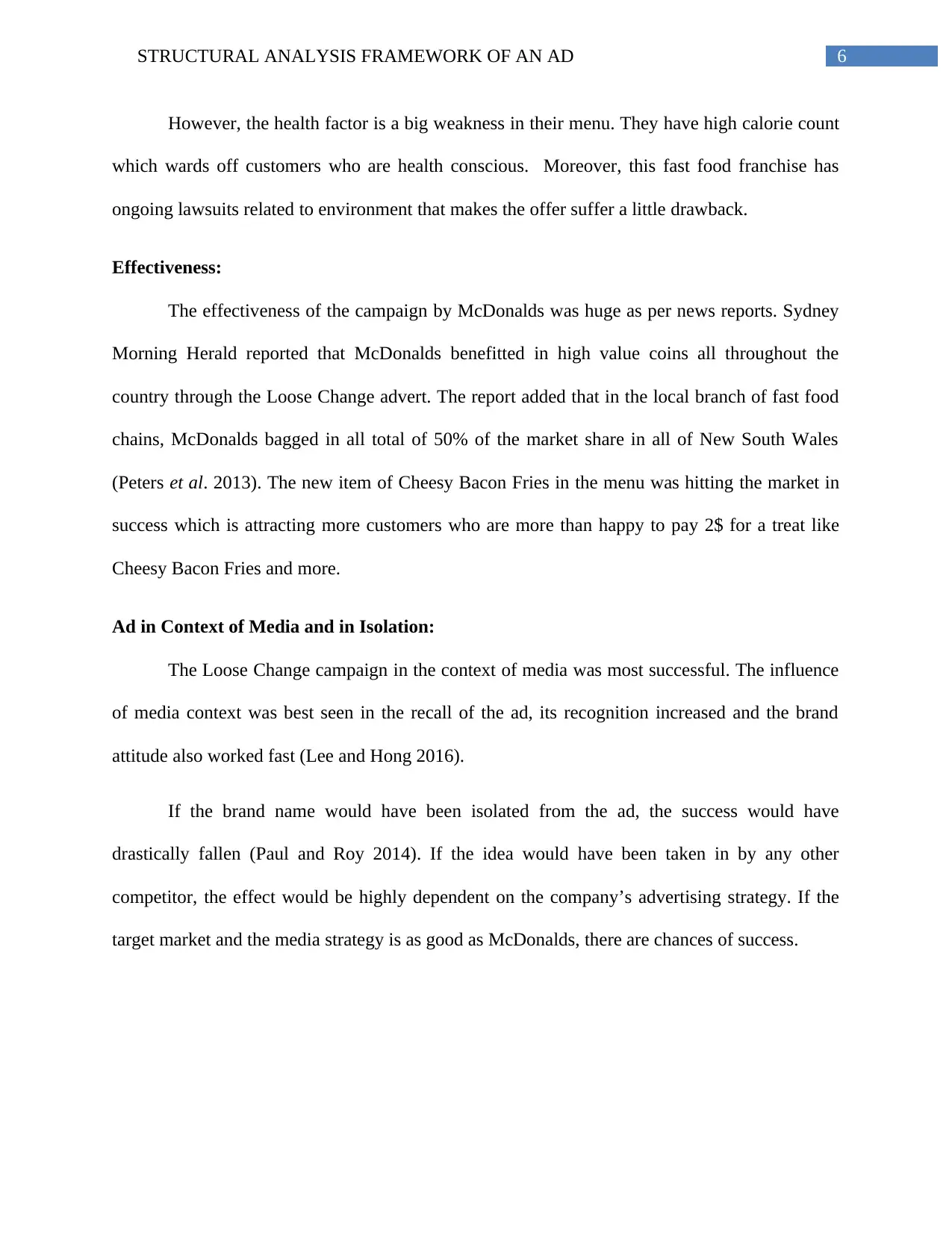
6STRUCTURAL ANALYSIS FRAMEWORK OF AN AD
However, the health factor is a big weakness in their menu. They have high calorie count
which wards off customers who are health conscious. Moreover, this fast food franchise has
ongoing lawsuits related to environment that makes the offer suffer a little drawback.
Effectiveness:
The effectiveness of the campaign by McDonalds was huge as per news reports. Sydney
Morning Herald reported that McDonalds benefitted in high value coins all throughout the
country through the Loose Change advert. The report added that in the local branch of fast food
chains, McDonalds bagged in all total of 50% of the market share in all of New South Wales
(Peters et al. 2013). The new item of Cheesy Bacon Fries in the menu was hitting the market in
success which is attracting more customers who are more than happy to pay 2$ for a treat like
Cheesy Bacon Fries and more.
Ad in Context of Media and in Isolation:
The Loose Change campaign in the context of media was most successful. The influence
of media context was best seen in the recall of the ad, its recognition increased and the brand
attitude also worked fast (Lee and Hong 2016).
If the brand name would have been isolated from the ad, the success would have
drastically fallen (Paul and Roy 2014). If the idea would have been taken in by any other
competitor, the effect would be highly dependent on the company’s advertising strategy. If the
target market and the media strategy is as good as McDonalds, there are chances of success.
However, the health factor is a big weakness in their menu. They have high calorie count
which wards off customers who are health conscious. Moreover, this fast food franchise has
ongoing lawsuits related to environment that makes the offer suffer a little drawback.
Effectiveness:
The effectiveness of the campaign by McDonalds was huge as per news reports. Sydney
Morning Herald reported that McDonalds benefitted in high value coins all throughout the
country through the Loose Change advert. The report added that in the local branch of fast food
chains, McDonalds bagged in all total of 50% of the market share in all of New South Wales
(Peters et al. 2013). The new item of Cheesy Bacon Fries in the menu was hitting the market in
success which is attracting more customers who are more than happy to pay 2$ for a treat like
Cheesy Bacon Fries and more.
Ad in Context of Media and in Isolation:
The Loose Change campaign in the context of media was most successful. The influence
of media context was best seen in the recall of the ad, its recognition increased and the brand
attitude also worked fast (Lee and Hong 2016).
If the brand name would have been isolated from the ad, the success would have
drastically fallen (Paul and Roy 2014). If the idea would have been taken in by any other
competitor, the effect would be highly dependent on the company’s advertising strategy. If the
target market and the media strategy is as good as McDonalds, there are chances of success.
Paraphrase This Document
Need a fresh take? Get an instant paraphrase of this document with our AI Paraphraser
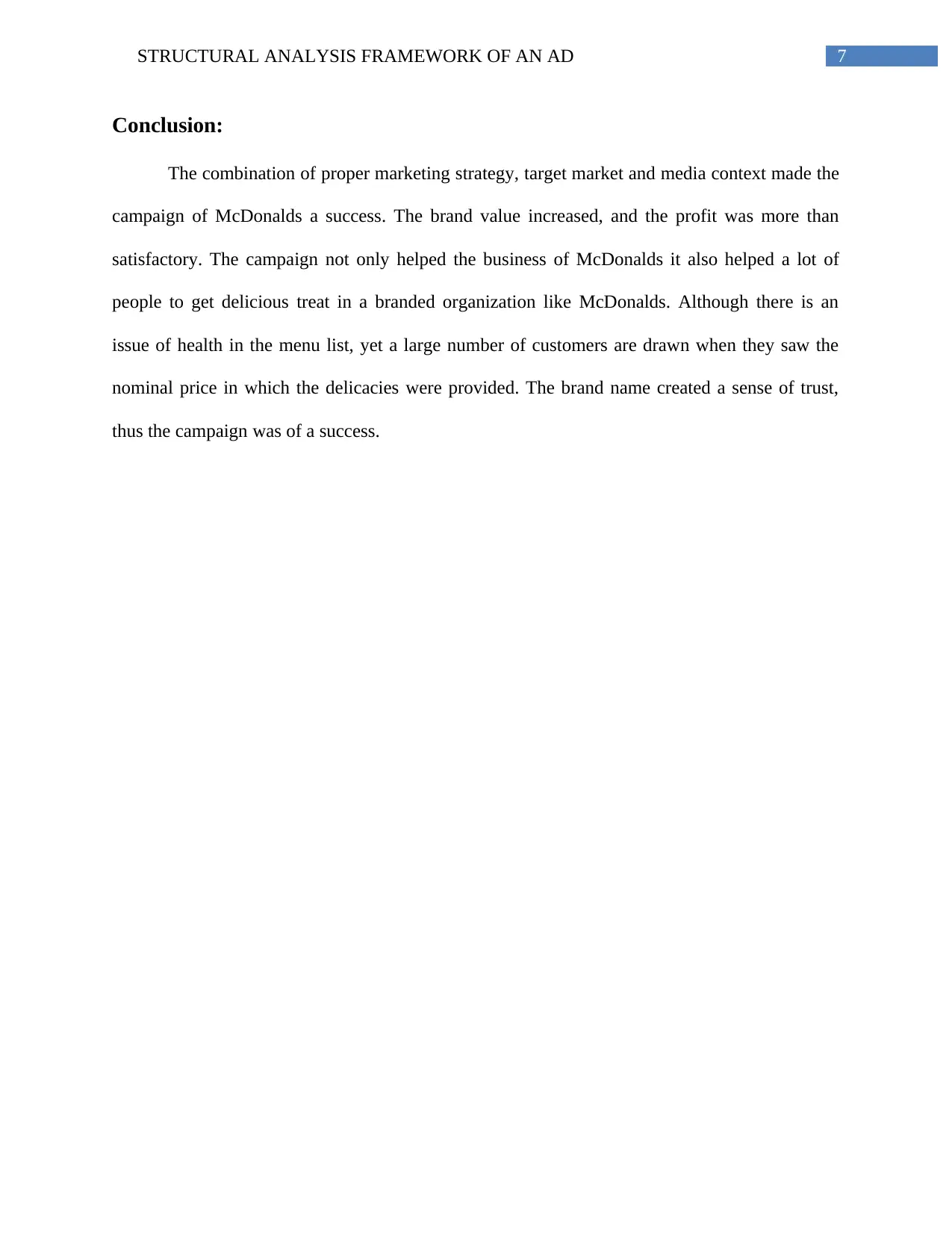
7STRUCTURAL ANALYSIS FRAMEWORK OF AN AD
Conclusion:
The combination of proper marketing strategy, target market and media context made the
campaign of McDonalds a success. The brand value increased, and the profit was more than
satisfactory. The campaign not only helped the business of McDonalds it also helped a lot of
people to get delicious treat in a branded organization like McDonalds. Although there is an
issue of health in the menu list, yet a large number of customers are drawn when they saw the
nominal price in which the delicacies were provided. The brand name created a sense of trust,
thus the campaign was of a success.
Conclusion:
The combination of proper marketing strategy, target market and media context made the
campaign of McDonalds a success. The brand value increased, and the profit was more than
satisfactory. The campaign not only helped the business of McDonalds it also helped a lot of
people to get delicious treat in a branded organization like McDonalds. Although there is an
issue of health in the menu list, yet a large number of customers are drawn when they saw the
nominal price in which the delicacies were provided. The brand name created a sense of trust,
thus the campaign was of a success.
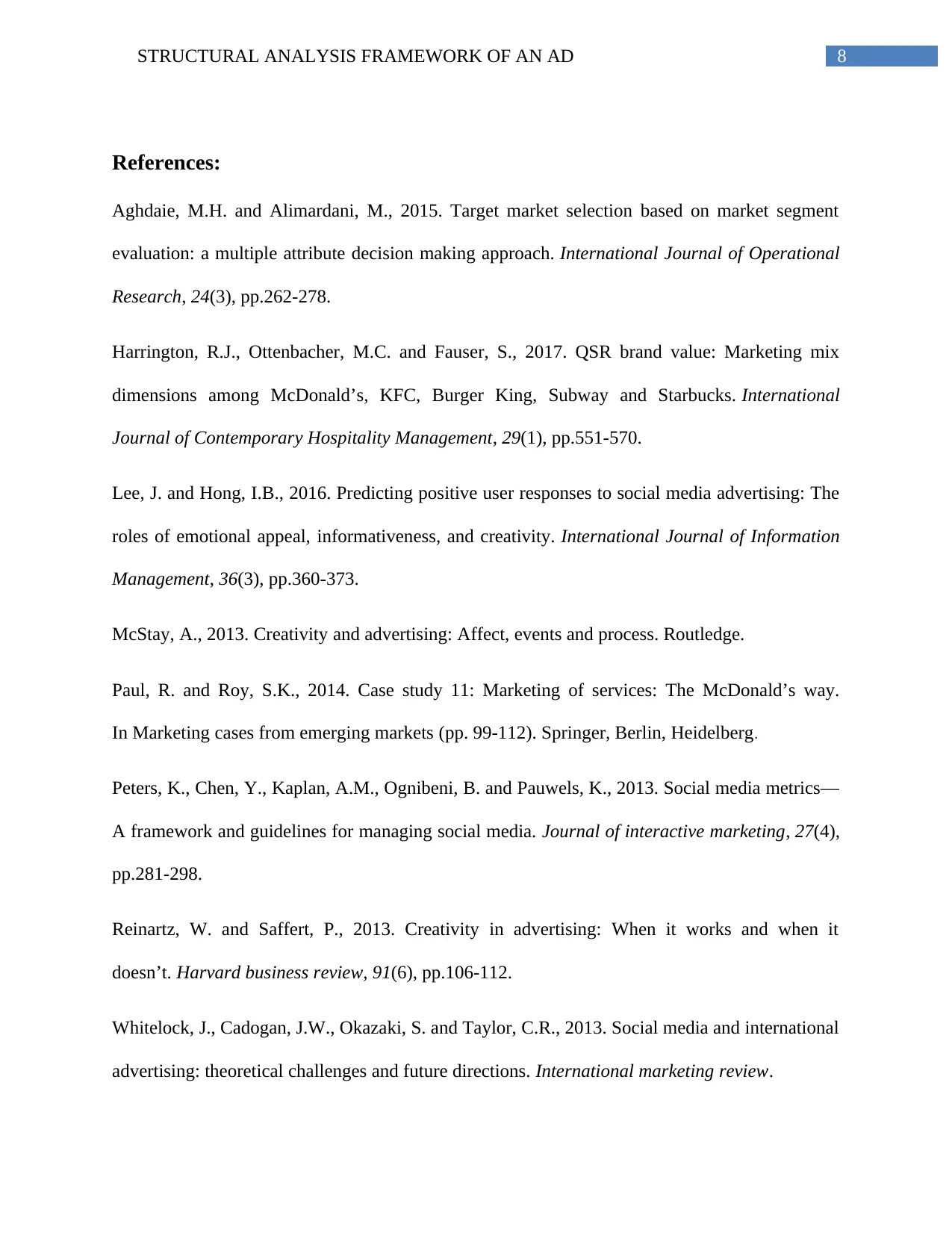
8STRUCTURAL ANALYSIS FRAMEWORK OF AN AD
References:
Aghdaie, M.H. and Alimardani, M., 2015. Target market selection based on market segment
evaluation: a multiple attribute decision making approach. International Journal of Operational
Research, 24(3), pp.262-278.
Harrington, R.J., Ottenbacher, M.C. and Fauser, S., 2017. QSR brand value: Marketing mix
dimensions among McDonald’s, KFC, Burger King, Subway and Starbucks. International
Journal of Contemporary Hospitality Management, 29(1), pp.551-570.
Lee, J. and Hong, I.B., 2016. Predicting positive user responses to social media advertising: The
roles of emotional appeal, informativeness, and creativity. International Journal of Information
Management, 36(3), pp.360-373.
McStay, A., 2013. Creativity and advertising: Affect, events and process. Routledge.
Paul, R. and Roy, S.K., 2014. Case study 11: Marketing of services: The McDonald’s way.
In Marketing cases from emerging markets (pp. 99-112). Springer, Berlin, Heidelberg.
Peters, K., Chen, Y., Kaplan, A.M., Ognibeni, B. and Pauwels, K., 2013. Social media metrics—
A framework and guidelines for managing social media. Journal of interactive marketing, 27(4),
pp.281-298.
Reinartz, W. and Saffert, P., 2013. Creativity in advertising: When it works and when it
doesn’t. Harvard business review, 91(6), pp.106-112.
Whitelock, J., Cadogan, J.W., Okazaki, S. and Taylor, C.R., 2013. Social media and international
advertising: theoretical challenges and future directions. International marketing review.
References:
Aghdaie, M.H. and Alimardani, M., 2015. Target market selection based on market segment
evaluation: a multiple attribute decision making approach. International Journal of Operational
Research, 24(3), pp.262-278.
Harrington, R.J., Ottenbacher, M.C. and Fauser, S., 2017. QSR brand value: Marketing mix
dimensions among McDonald’s, KFC, Burger King, Subway and Starbucks. International
Journal of Contemporary Hospitality Management, 29(1), pp.551-570.
Lee, J. and Hong, I.B., 2016. Predicting positive user responses to social media advertising: The
roles of emotional appeal, informativeness, and creativity. International Journal of Information
Management, 36(3), pp.360-373.
McStay, A., 2013. Creativity and advertising: Affect, events and process. Routledge.
Paul, R. and Roy, S.K., 2014. Case study 11: Marketing of services: The McDonald’s way.
In Marketing cases from emerging markets (pp. 99-112). Springer, Berlin, Heidelberg.
Peters, K., Chen, Y., Kaplan, A.M., Ognibeni, B. and Pauwels, K., 2013. Social media metrics—
A framework and guidelines for managing social media. Journal of interactive marketing, 27(4),
pp.281-298.
Reinartz, W. and Saffert, P., 2013. Creativity in advertising: When it works and when it
doesn’t. Harvard business review, 91(6), pp.106-112.
Whitelock, J., Cadogan, J.W., Okazaki, S. and Taylor, C.R., 2013. Social media and international
advertising: theoretical challenges and future directions. International marketing review.
⊘ This is a preview!⊘
Do you want full access?
Subscribe today to unlock all pages.

Trusted by 1+ million students worldwide

9STRUCTURAL ANALYSIS FRAMEWORK OF AN AD
1 out of 10
Your All-in-One AI-Powered Toolkit for Academic Success.
+13062052269
info@desklib.com
Available 24*7 on WhatsApp / Email
![[object Object]](/_next/static/media/star-bottom.7253800d.svg)
Unlock your academic potential
Copyright © 2020–2025 A2Z Services. All Rights Reserved. Developed and managed by ZUCOL.
